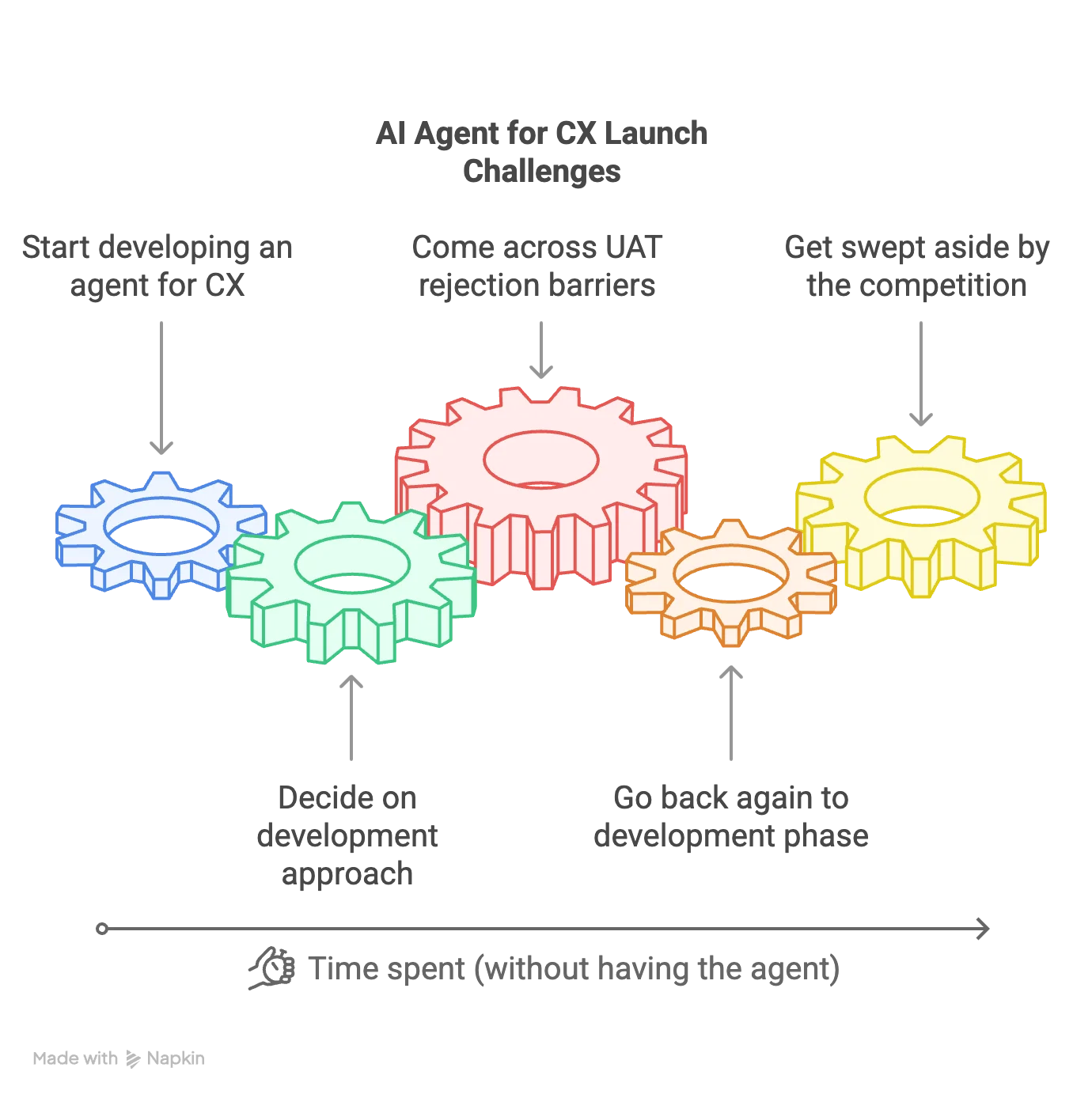
Paula Cionca
Apr 24, 2025
Launching an AI chatbot for your business often feels like a marathon. Company executives are already calling it a complicated matter from a technical standpoint. In a recent survey conducted by an automation vendor, almost nine out of ten respondents said that their companies would need to upgrade their stack to deploy AI agents.
But, provided that companies finally update their stacks, there’s one hurdle that consistently slows things down before launch: manual user acceptance testing, or UAT.
And it’s here where things usually stall.
The UAT Bottleneck
Because, usually, manual user acceptance testing takes simply too long, sometimes even months, according to anecdotal reports. This headache is especially painful for enterprises in industries like banking, insurance, telecom, retail, travel, and healthcare. These industries have to deal with compliance, prepare for scalability, and keep customer satisfaction up if they want to survive. And they can’t risk launching a chatbot that answers dangerously, but they also can’t risk waiting too long without an AI agent.
For mid-market companies, from e-commerce to regional airlines, the complexity is made worse by scarce in-house expertise (this is totally acceptable) and the need to test in multiple languages and channels (Not as easy as it initially seems — LLMs can go rogue in multiple languages).
So, what should companies do to make sure that UAT does not slow down their new AI agents deployment?
What is Manual User Acceptance Testing?
Manual user acceptance testing (UAT) is a step in software development in which actual users test software in real-life situations to make sure it works for what they need to do. Manual user acceptance testing is done before launch. This is one of the final steps in software development because it confirms the software does what users need. Companies or organizations that are not diligent enough with user acceptance testing usually make headlines, are the subject of Harvard papers, and might end up spending millions of dollars to control the damage.
Manual UAT is done by actual, non-technical users. A company’s staff can do UAT because they’re replicating the behavior their potential users will have. This is why user acceptance testing is different to QA, or quality assurance, testing.

The Problem: Manual User Acceptance Testing is a Bottleneck
Companies can either develop an AI agent in-house or outsource it. Once the developers finish the AI agent, businesses typically move it to a UAT environment. In this phase, internal employees are asked to manually test the chatbot. They need to simulate conversations, log bugs (even if they don’t know how to check them!), take down notes and feedback, and figure out if the AI agent meets the expected behaviors. This sounds simple enough, but in practice, it’s a massive time sink.
Manual UAT is a bottleneck because:
- Requires companies to allocate employees on repetitive testing (instead of on work). Can take up to 3 months if the workflows are complex enough. Or it can take much longer if there’s not a well-organized process.
- Becomes even more cumbersome when working with external contractors who may need back-and-forth feedback cycles, NDAs, signatures, and such.
- Delays the transition to the bug-fixing phase.
- If not done properly, companies risk launching a chatbot that still underperforms in real user scenarios.
- Is especially difficult when testing multilingual conversations and omnichannel formats like WhatsApp, voice IVR, or webchat.
For AI agents that are designed to scale across languages and contexts, these delays can mean missed opportunities and prolonged feedback loops.
But it really looks like manual UAT is the only way. In the end, companies can’t put out a chatbot that answers with confidential info or that answers awfully unacceptable things to the userbase (and this has happened.)
The Better Way: Accelerated Testing with AI Agent Simulations
What if you could simulate thousands of conversations based on your business personas and their behaviors—before going live?
With Genezio, that’s exactly what you can do.
Introducing Genezio’s Agentic Testing Platform
Genezio helps you skip the manual testing backlog by generating industry-specific AI conversations aligned to your workflows. You only need to:
- Choose from our Test Agents Library or create new agents with automatically generated scenarios and behaviors.
- Refine the scenarios and define the desired outputs for each one.
- Create your simulation by selecting the agents, language, number of parallel conversations, and other specific configurations.
- Click Run ▶️ to launch the simulation.
- Access the report to review all conversations and explore the insights provided by Genezio.
We built Genezio so that it takes seconds for technical and non-technical staff to test their AI agents with a simulation.
Behind the scenes, Genezio will:
- Simulate customer-agent interactions using custom personas.
- Test for accuracy, coherence, tone, compliance, and business alignment.
- Detect failure modes like bot loops, unhandled inputs, or hallucinated facts.
- Validate multilingual performance and consistency across channels.
- Stress test your AI agent with thousands of concurrent sessions.
- Provide detailed reports daily or weekly.
With Genezio, companies can shrink down their UAT time, and stop doing manual UAT altogether. With this platform, companies can test and go live with the AI agents in the shortest possible time window.
And, most importantly, businesses can make sure that their chatbots are working reliably as soon as they’re live.
Why Continuous Testing Matters (Even Post Go-Live)
One common myth is that testing ends at launch. In reality, it should never stop.
AI agents interact with evolving databases, changing APIs, and all kinds of user behaviors. Without continuous testing, you risk:
- Responses based on outdated or unsynced data.
- Broken integrations due to silent API changes.
- Regressions introduced by new intents or fine-tuning.
- Negative customer experiences, such as irrelevant suggestions or data leakage.
Real-World Examples:
- A retail chatbot might recommend out-of-stock items.
- A healthcare assistant may provide outdated policy information.
- A finance bot could offer unsanctioned advice or breach compliance terms.
- Even worse—a healthcare assistant might offer financial advice because the user jail-broke it into saying it. And now the company is liable!
With Genezio, your AI agent is continuously tested for mistakes across scenarios that matter most to your business. Our regression testing framework alerts teams to new bugs or undesired behavior as soon as it happens. Companies can use our alerts to fix issues before customers notice.
Solving Enterprise-Grade Pain Points
Genezio addresses the core challenges faced by both enterprises and mid-market adopters:
- Fear of Chatbot Failures: We simulate edge cases—angry users, slang, typos—so you uncover unknown failure modes before launch.
- Brand and Compliance Risks: We evaluate every interaction for tone, branding, and forbidden data to guard against reputational or legal risks.
- Delayed Launches and Cost Overruns: Automatic UAT means that companies can go live faster and also cut down the costs of internal testing.
- Maintenance and Regression Challenges: Post-launch updates often break functionality. Our automated regression testing means that you can go back to a version that worked.
- Scalability and Performance: Need to test millions of interactions or peak traffic events? Genezio’s load testing handles it.
- Multilingual, Multi-Channel Complexity: We simulate inputs across languages and platforms, like WhatsApp vs. a web widget.
See It In Action: Test your AI Agent with Genezio Now
Manual user acceptance testing can be slow, but it’s still necessary. A good alternative is to go automatic and leverage a platform that’s specifically designed to address AI agents and their (potentially) erratic behavior.
If you want to understand how Genezio works, we offer sample reports and conversation logs so you can see the platform in action. You can check some of our core features like intent recognition to performance benchmarking.
Don’t let manual testing stall your AI strategy. Move faster, with more confidence, using intelligent agentic testing.
One of the best parts about Genezio’s testing is that it takes seconds to get started. You just need an URL pointing to your agent. Both tech and non-technical staff can run a simulation.
Get Your DemoGenezio is the industry-first platform that lets you evaluate AI agents like you would test software—reliably, automatically, and at scale.
Article contents
Subscribe to our newsletter
DeployApps is a serverless platform for building full-stack web and mobile applications in a scalable and cost-efficient way.
Related articles
More from AI
Multilingual Customer Service: Cost of Multilingual Misfires in AI Customer Service
Luis Minvielle
Jun 30, 2025






